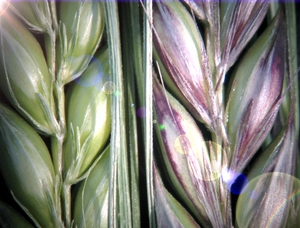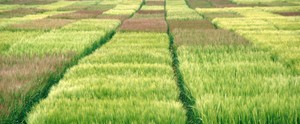 Scientists at the National Institute of Agricultural Botany (NIAB) have identified the genes that encode important visible differences in barley. The breakthrough is a major step forward in unravelling the genetic determinants controlling traits including yield, quality and disease resistance.
Scientists at the National Institute of Agricultural Botany (NIAB) have identified the genes that encode important visible differences in barley. The breakthrough is a major step forward in unravelling the genetic determinants controlling traits including yield, quality and disease resistance.
The DNA variants identified control a range of characters, from the eye-catching variations in barley awn-pigmentation to the shape and the structure of the ear, fundamental to differences in yield. In one case, the scientists were able to show that the absence of purple pigment, or anthocyanin, in the plant is probably controlled by a natural mutation within a gene thought to regulate the pigment’s biosynthetic pathway.
The collaborative investigation between UK scientists at NIAB, the Scottish Crop Research Institute and the University of Birmingham, as well as interested commercial partners, established and characterised a comprehensive set of UK barley varieties using state-of-the-art DNA profiling techniques. The Cambridge-based NIAB research team pinpointed stretches of barley DNA code associated with observed variation in characters using statistical techniques pioneered in human genetics called ‘association mapping’.
 “Barley does not yet have a complete genome sequence available, but by combining association mapping with comparative analysis of gene content in related plant species, we’ve been able to focus in on the likely genetic variant that determines whether barley can produce anthocyanin,” says NIAB plant scientist Dr James Cockram.
“Barley does not yet have a complete genome sequence available, but by combining association mapping with comparative analysis of gene content in related plant species, we’ve been able to focus in on the likely genetic variant that determines whether barley can produce anthocyanin,” says NIAB plant scientist Dr James Cockram.
“Our results are just the tip of a very large iceberg,” says Dr Donal O’Sullivan, study leader in NIAB’s Genetics and Breeding Research Programme.
“By showing that we can use approaches from human genetics and apply them successfully in crops, we will now be able to investigate the natural genetic variation that controls agronomically important traits in barley, as well as other crops.
“This includes tackling complex traits geared to providing better information and improved varieties to farmers in the future. These may also be crucial in meeting an increased food demand from a growing world population, as well as confronting the challenges of climate change and reduced availability of land, water, and fertiliser,” says Dr O’Sullivan.
As well as opening up further research opportunities the results may also prove to be an additional method in variety evaluation, seed certification, and seed testing, lowering costs and reducing the potential for human error.
The study reports on a series of botanical characters usually collected in the process of NIAB’s day-to-day work in carrying out exact variety descriptions for regulatory purposes.
“For a grant of Plant Breeders’ Rights to be awarded a variety must be distinct, uniform and stable, otherwise known as DUS. These characters are not heavily influenced by growing conditions so were ideal for the project. Some are important in their own right and can impact on performance and quality. They are also relevant to breeders as they can prove the variety is pure,” explains Dr Cockram.
The researchers were fortunate to have access to a treasure trove of DUS varietal measurements accumulated since NIAB began variety trials as far back as 1919. This database extends to complicated multi-site and multi-season measurements including yield, disease, agronomic and quality characters, and not just in barley which featured in this study but to all major UK arable crops.
Recreating such datasets would be expensive today. Now that the techniques for mining and analysing historic variety trial data, has been successfully road-tested, the research team can explore the full potential of this data to reveal economically important genetic variation in more complex characters.
As part of a similar project in wheat, scientists at NIAB and the John Innes Centre (UK) are also using association mapping to locate genes controlling resistance to yellow rust, one of most important diseases constraining global wheat yields.
“We’ve already made rapid advancements in our understanding of the genetics of yellow rust resistance, which will help us breed new wheat varieties with increased natural resistance to this damaging disease,” says Dr O’Sullivan.
For further information contact:
Dr Donal O’Sullivan, study leader - Genetics and Breeding Research Programme, NIAB
T: 01223 342463
M: 07817 748717
E: donal.osullivan [at] niab.com ()
Dr James Cockram, research scientist, NIAB
T: 01223 342484
E: james.cockram [at] niab.com ()
Issued by:
Ros Lloyd,
FrontFoot Communications
T: 01487 831425
M: 07711 568164
E: ros.lloyd [at] frontfoot.uk.com ()
